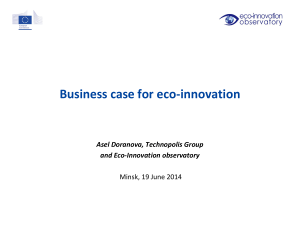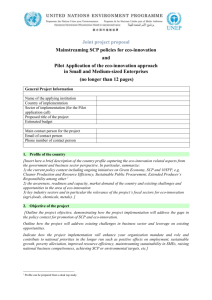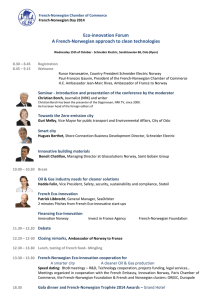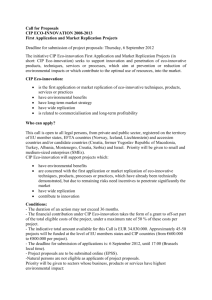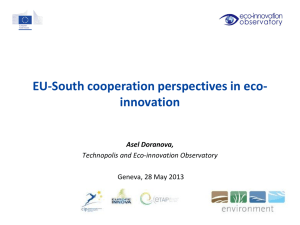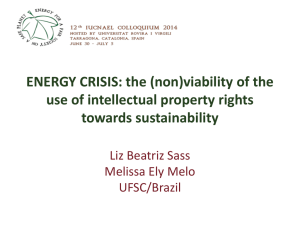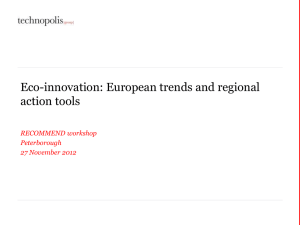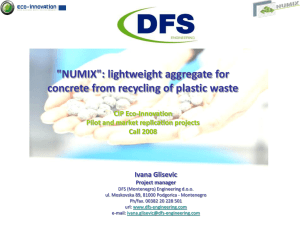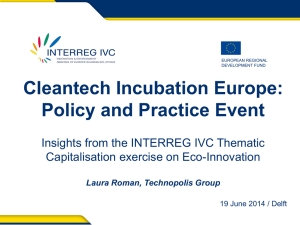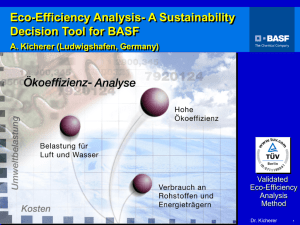3. key strategies for eco
advertisement
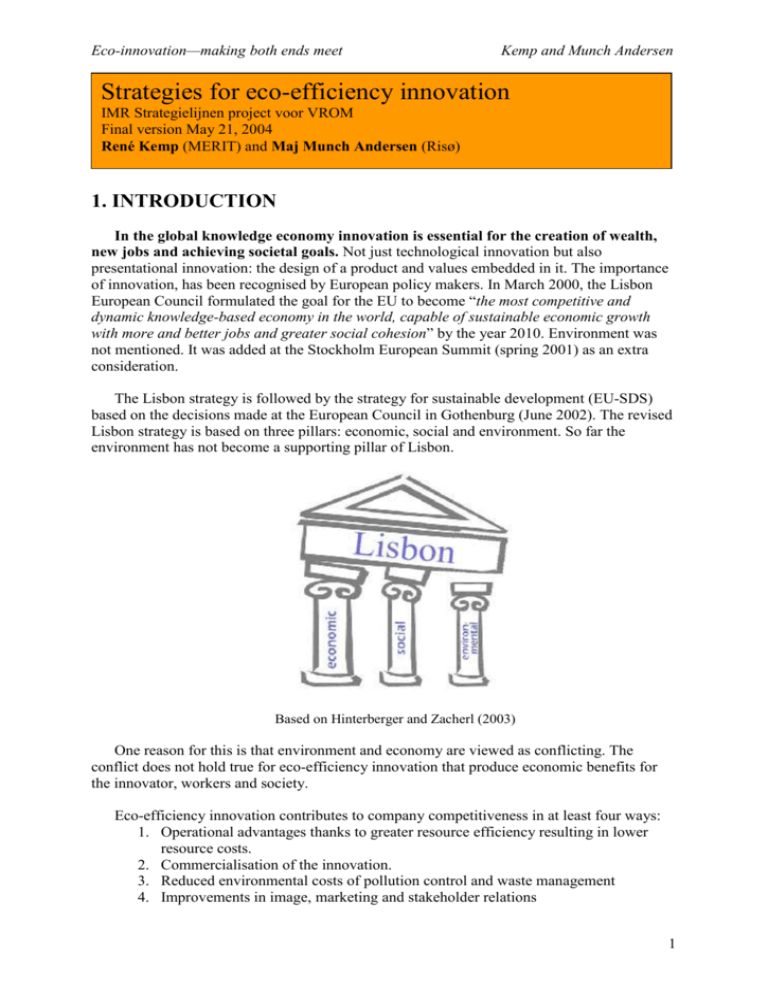
Eco-innovation—making both ends meet Kemp and Munch Andersen Strategies for eco-efficiency innovation IMR Strategielijnen project voor VROM Final version May 21, 2004 René Kemp (MERIT) and Maj Munch Andersen (Risø) 1. INTRODUCTION In the global knowledge economy innovation is essential for the creation of wealth, new jobs and achieving societal goals. Not just technological innovation but also presentational innovation: the design of a product and values embedded in it. The importance of innovation, has been recognised by European policy makers. In March 2000, the Lisbon European Council formulated the goal for the EU to become “the most competitive and dynamic knowledge-based economy in the world, capable of sustainable economic growth with more and better jobs and greater social cohesion” by the year 2010. Environment was not mentioned. It was added at the Stockholm European Summit (spring 2001) as an extra consideration. The Lisbon strategy is followed by the strategy for sustainable development (EU-SDS) based on the decisions made at the European Council in Gothenburg (June 2002). The revised Lisbon strategy is based on three pillars: economic, social and environment. So far the environment has not become a supporting pillar of Lisbon. Based on Hinterberger and Zacherl (2003) One reason for this is that environment and economy are viewed as conflicting. The conflict does not hold true for eco-efficiency innovation that produce economic benefits for the innovator, workers and society. Eco-efficiency innovation contributes to company competitiveness in at least four ways: 1. Operational advantages thanks to greater resource efficiency resulting in lower resource costs. 2. Commercialisation of the innovation. 3. Reduced environmental costs of pollution control and waste management 4. Improvements in image, marketing and stakeholder relations 1 Eco-innovation—making both ends meet Kemp and Munch Andersen Eco-efficiency innovation helps society to grow and prosper and achieve environmental improvements. It makes both ends meet by creating a competitive and innovative economy. Eco-efficiency innovation does not go at the expense of other types of innovation: it stimulates innovation and creativity to find new ways of achieving quality of life with little environmental and social impact. Eco-efficiency innovation should be distinguished from environmental technologies that treat pollution. Eco-efficiency should be an important competitive strategy of the European economy and -- with high-level business and government support -- could even become a EU trademark, recognised by customers and other stakeholders. No cost barriers are preventing this from happening; eco-efficiency in fact helps to reduce manufacturing costs and environmental costs while yielding a positive value to companies. In the knowledge economy, reputation values are more important, becoming part of the bottom line. But many things are hindering a transition to a greener, more responsible and sustainable market economy. Ecoefficiency and responsible behaviour require attention, capability, knowledge, markets recognising environmentally responsible behaviour, and governments rewarding good environmental behaviour. Eco-efficiency depends on companies becoming pro-active—seeking improvements on their own as a part of their competitive strategies rather than in response to specific regulations. This does not happen of its own, despite some stimuli for it. Making companies pro-active requires change at multiple levels: the government-business relationship has to change, producers and costumers must develop new competences and the economic frame conditions have to change too. It is a political challenge as much as it is a challenge for business. It calls for partnership between companies, between governments and departments (willing to learn from each other) and between companies and government. It is a long process, hampered by 30 years of reactive strategies and compartmentalised policies. This report discusses strategies for promoting eco-efficiency innovation. It addresses the question: How to make eco-innovation a competitive strategy in the knowledge economy? There is not one strategy but many strategies for this, which are grouped in 6 categories 1. Making companies proactive 2. Improving sustainability assessment by companies and customers 3. Improving the system of innovation for eco-innovation 4. Targeted policies for eco-innovations 5. The use of market-based instruments 6. Policy integration The strategies are based on a number of considerations, which are described first. There is a background report going more deeply into the considerations, offering empirical evidence and more fully developed arguments.1 1 The background report can be obtained through the authors and through VROM. To receive the report please send an email r.kemp@merit.unimaas.nl and annelies.hermans@minvrom.nl 2 Eco-innovation—making both ends meet Kemp and Munch Andersen 2. CONSIDERATIONS 1. Innovation is key to greater prosperity. To sustain means to innovate. Complacency is not an option. Whereas innovators bear the upfront cost of action, society bears the cost of inaction. Inaction; not an option Through 2. Whilst economic growth is desirable, people also need clean air and bequeath ecoenvironmental endowments, both of which have economic value. Economy and innovation environmental impacts should be co-optimised. We need to find ways of combining we can cohigh levels of prosperity with environmentally sustainable development, both optimise nationally and globally. economy and environment 3. The EU is strongly committed to sustainable development (Göteborg council) and The time is right Companies are key Development traps competitiveness (Lisbon council). The two things have been linked through ETAP2: Achieving the Lisbon objectives requires investments to be substantially increased. This provides an ideal opportunity to integrate environmental and wider sustainability considerations into these investment decisions. Eco-efficiency innovation contributes to the Lisbon goal and is a way to get to Lisbon. More attention should be given to eco-efficiency innovation in the upcoming Innovation action plan of the Commission. 4. Companies are central to the solution of sustainability problems. The way in which companies innovative - how they organise their production, and the products and services they choose to develop and produce - exert a crucial influence on our wellbeing and the environment in which we live. The strategies made by companies depend on their appraisal of market potentials and risks. But companies are part of networks and national systems of innovation on which their ability and willingness to innovate depends. 5. Environmental problems are not just a problem of prices not reflecting societal costs but best seen as development traps: The cumulative and embedded nature of technical change means that we are locked into non-eco-efficient systems and products. Internalising the environmental costs is a necessary but not a sufficient condition for escaping lock-in. The systems model of innovation shows that ecoinnovation requires competences and opportunities besides price incentives. 6. There are many barriers to eco-efficiency innovation, especially in small and medium-sized companies. These have to do with competence, attention, economic incentives, funds, entrepreneurship, short-termism. Despite the priority given by society over recent years to achieving environmental improvements, only a limited number of companies have been able to utilise the trend towards growing concern for the environment to obtain a competitive advantage. There are many barriers Ecoinnovation is efficient 7. Integrating environmental issues into business strategies is potentially an effective means of achieving the necessary improvements in eco-efficiency, both for society as well as for business. There is therefore a need to find ways of developing an eco- 2 COM(2004) 38 final. Communication from the Commission to the Council and the European Parliament. Stimulating Technologies for Sustainable Development: An Environmental Technologies Action Plan for the European Union. 3 Eco-innovation—making both ends meet Kemp and Munch Andersen efficient market economy which rewards eco-efficiency innovation and of improving the innovation system for eco-innovation. Helping consumers assess 8. Consumers lack environmental competencies, which makes it very difficult for them to assess and understand the environmental aspects of products. There are also considerable knowledge requirements of eco-innovations, not just for consumers but also for other actors: investors, insurance agents, research institutions, public authorities and consumers. These knowledge requirements are overlooked in policy making. From costbased strategies 9. Pure cost strategies no longer suffice in the strong global competition. Rather the ability to innovative and develop new market opportunities is important. The capacity to develop, absorb and apply knowledge is central to competitiveness. This goes especially for the affluent, high-cost European economies that need to find novel parameters to compete on. -- to knowledge and values 10. While it by now is well recognized that competition on knowledge is central in the knowledge economy, the rising importance on competition on values is less recognized. The idea of presentational innovation (as a third type of innovation along technological and organisational innovation) captures this and may have implications for eco-efficiency innovations. Presentational innovation relates to the rising role of branding, image and design for competitiveness. The identity a product gives, the story associated to it, is as important as its function to many (affluent) consumers. Even in poorer economies a brand such as Coca-Cola is capable of achieving rising market shares despite high costs because of its presentational value. The modern consumer wants to know a lot more about a product than its price. 11. Competition on values goes beyond consumerism. It is also associated with the overall need for companies to maintain a good image towards their stakeholders. Competition Particularly the ability to attract investors and competent employees is a key on values competitive factor and a good image is increasingly important in both cases. -- is increasingly important in the new knowledge economy 12. The higher levels of knowledge in society and the rising transparency associated with the information technology revolution (such as the internet), means that companies’ image are a lot more vulnerable to critique. The importance of the image/brand, especially for transnational companies, is leading to a changing role of business in society. More and more especially big companies develop strategies for corporate social responsibility (CSR). The knowledge economy seems to have the potential for changing into a “socially responsible economy” if we manage to support these rising but delicate trends. 13. Much indicates that presentational innovation will be increasingly important for European companies. The increasing importance of the “emotional value” of products Multiple sources of has important implications for innovation. Responsible entrepreneurship caters to this. competitiveCompanies need to find ways of utilizing the rising competition on values in the new ness economy. 14. The new economy is not only a knowledge economy but also an economy based on self-regulation and responsible behaviour. Europe is leading in this direction. This could be strengthened politically and by policy. Eco-efficiency and responsible 4 Eco-innovation—making both ends meet Ecoefficiency as a EU trademark Kemp and Munch Andersen entrepreneurship could become a trademark of European companies. This will encourage customers, investors and competent employees to select European companies as their transaction partners giving European companies a competitive edge in the world market. A responsi- 15. A responsible profile will be a quality mark and a prerequisite for making busines in ble profile is the 21st century. It is not a matter of being virtuous but of improved quality. The EU a sign of should lead the way and benefit from setting the global standard in this respect. This leadership requires leadership from business and government. Bottom-up initiatives should be supported from the top. 16. Eco-innovation leads to progress in eco-efficiency. Eco-efficiency is a management Ecophilosophy to guide and measure companies and other actors development in efficiency is a manageenvironmental performance. Eco-efficiency is about value and quality for all ment philoactors: to achieve more value with less environmental impact. It is a concept from sophy -- for business not environmentalists. all actors It is about more value with less environment al impact 17. Eco-efficiency is here understood as a comprehensive notion that may be applied to various levels of analysis, e.g. the single company, the industrial sectors, the region or the entire economy. Eco-efficiency may be achieved in many ways including behavioural changes. The focus of policy should be on all innovation, not just on environmental technologies. The WBCSD has identified seven elements to improve eco-efficiency3: o Reduce material intensity o Reduce energy intensity o Reduce dispersion of toxic substances o Enhance recyclability o Maximize use of renewables o Extend product durability o Increase service intensity 18. Eco-efficiency innovations may be developed with or without the explicit aim of reducing environmental harm. They may be a side effect of the usual business goals such as productivity and enhanced product quality. GPT 19. General purpose technologies are an important source for achieving environmental benefits.4 Examples are: new materials, fuel cells, biotechnology and sensors. The utilization of GPT may require organisational and institutional adaptation, apart from technological innovation. Societal benefits have to be recognised and acted upon. Some technologies (such as biotechnology and electricity from hydrogen) pose risks, which have to be assessed and proactively dealt with. 20. For the eco-innovator there are both direct and indirect benefits that may enhance competitiveness. World Business Council for Sustainable Development (2000): Eco-efficiency – creating more value with less impact. 4 Blueprints for an Integration of Science, Technology and Environmental Policy, final report written by Klaus Rennings, René Kemp, Matteo Bartolomeo, Jens Hemmelskamp and David Hitchens (2004), based on a series of workshops of a network of European environmental innovation experts) 3 5 Eco-innovation—making both ends meet Kemp and Munch Andersen The direct benefits for the innovator consist of - Operational advantages such as cost savings from greater resource productivity and better logistics - Sales from commercialisation Benefits for business The indirect benefits for the innovating company consist of - Better image - Better relations with suppliers, customers and authorities - An enhanced innovation capability overall thanks to contacts with knowledge holders - Health and safety benefits - Greater worker satisfaction The indirect benefits have value in the longer term and are the most important driver for proactive behaviour. (See appendix for a quantification of company benefits). Societal benefits 21. For society there are employment benefits and health benefits as well as economic savings as innovation at the source (the company) is the most efficient way to reduce environmental impacts.5 22. Surveys show that the majority of companies know very little of either the costs nor benefits of their environmental activities. Figures on benefits from eco-innovation are not collected by companies on their own or by statistical agencies. This leads many of them to believe that environment is a burden rather than an asset. This is an important barrier to eco-innovation. Own or others experiences (about net benefits from eco-efficiency) are instrumental in changing the mind set. Costs issue is wrongly perceived 23. The costs issue of environment is wrongly perceived by policy makers and business: Against the costs of environmental measures there are benefits: both benefits for society (health benefits from less pollution, clean water for recreation and other types of water use) and benefits for the innovating company. For many ecoinnovating companies, the benefits for the company exceed the costs. If you don’t deal with pollution and waste in the company you must deal with it somewhere else or at a later time as with polluted soils. Costs must be incurred either way. They are unavoidable. Innovation can help to reduce these costs or achieve greater environmental benefits. The need for organizational and strategic renewal 24. 30 years of reactive strategies means that most companies do not look beyond regulatory effects. They do not have the attention nor the management systems, organisational structures or competencies to appreciate or utilize potential benefits from their environmental investments. As a consequence, suboptimal environmental strategies are widespread. This is critical since signals are still weak on the green market and risks and uncertainties are high. In order to create competitive advantages in eco-innovative products companies must be active market makers. 5 The IMPRESS study (Rennings and Zwick, 2003) covering all manufacturing and service sectors in five European countries established that the adoption of the “most environmentally important” innovation had no effect on sales and prices for more than 83 % of the establishments. For 16 % of the establishments, sales increased. In 1% of the establishments, sales decreased. Prices increased in 9 % of the firms but in most cases by less than 5 %. Prices decreased also in 9 % of the firms. 6 Eco-innovation—making both ends meet Kemp and Munch Andersen Few companies have the strategies and competencies to do that. Consequently many companies have been dissappointed when pursuing proactive environmental strategies. 3. KEY STRATEGIES FOR ECO-INNOVATION Eco-efficiency is a management philosophy that fits with competitiveness and allows us to move away from prescriptive regulations to greater self-regulation and market-based policies. Eco-efficiency may thus be stimulated without going down the road of more regulation. The challenge is to achieve it with less regulation by turning eco-efficiency into a mainstream business strategy. A transition towards a more eco-efficient economy requires action and renewal by many actors. Government, business, investors, consumers and researchers and educators all have their important roles to play in redesigning the innovation system. Below we present 6 strategies for how governments may support this transition process towards greater an eco-efficient economy. They partially overlap and each consists of a set of substrategies. Instruments aspects are touched upon but not really worked out, as this is the topic of another project. This document focuses on the strategies issues. In our view, the main strategies for eco-efficient innovation are: 1. Making companies proactive 2. Improving sustainability assessment by companies and customers 3. Improving the system of innovation for eco-innovation 4. Targeted policies for eco-innovations 5. The use of market-based instruments 6. Policy integration It should be realized that all six strategies are needed for developing an eco-efficient market economy with good conditions for eco-innovations. However, more attention should be made to the interplay and balance between the six groups of strategies. It matters how they are used (the relative mix). If company self-regulation is to play a major role, regulation and eco-taxation must provide incentives for this. The scope of each strategy is limited: not all companies can be made proactive and it is not feasible to have emissions trading policies for thousands of pollutants. We will now describe and discuss these 6 strategies, which in our view constitute the main strategies for promoting eco-efficiency innovation. Ad 1. MAKING COMPANIES PROACTIVE This is perhaps the most important strategy of all on which a great deal of the success hinges. Companies should be encouraged to seek eco-efficiency improvements. Strategies for this are: o Making business realise the economic potentials of eco-innovation in the form of less costs in waste management, energy and materials, greater sales and better image. The use of environmental management systems are one way of realising this. Up to now it is mainly the big companies who have adopted such systems. Small and 7 Eco-innovation—making both ends meet Kemp and Munch Andersen medium companies should be encouraged also to move in this direction. They could start with relatively simple projects, with further advances based on economic successes. Environment should be seen as an asset. For this, positive experiences are needed. Improved stakeholder relations and self-esteem are just as important as immediate pecuniary gains. All this helps to cement eco-efficiency as a goal within the company. In the future “product stories” will be an important factor in customer decisions, certainly in developed countries. This is already being realised by the greater players committed to Corporate Social Responsibility (CSR) strategies (as a presentational innovation). For small companies, the local profile is important and could be exploited by means of policy. There is a role for trade associations and local business associations here. o Reward companies who engage in self-regulation. The rewards could consist of flexible enforcement of permits, involve them in discussions on long-term goals, financial support, public recognition and acknowledgement, perhaps presenting them as role models. Self-regulation is not a substitute for regulation. Economically marginal companies would grasp it as an opportunity for doing nothing. Companies must earn it. There are several grades of self-regulation—based on different degrees of voluntarism (Andrews, 1998) o Benchmarking for eco-efficiency. Measuring and benchmarking progress on ecoefficiency and proactive strategies could provide strong incentives for self-regulation. Benchmarking is needed for individuals and families to change consumption patterns and for companies, industrial sectors and national innovation systems to make continuous progress in eco-efficiency. To date it is almost impossible to evaluate the environmental aspects of everyday actions. Ad 2. IMPROVING SUSTAINABILITY ASSESSMENT BY COMPANIES AND CUSTOMERS Improving assessment and capabilities is essential for bringing eco-innovations to the market. Companies are certainly forward-looking but their often lack good technology assessment and market assessment skills. They also lack environmental assessment skills, as do consumers. Assessment skills should improved. For environmental assessment, ecolabels are a strategy useful for eco-pioneers but probably too much environment-focussed for the wider group of companies. o Encourage companies to anticipate and constructively deal with the future. In the globalising economy assessment of markets and new technologies is key to the longterm survival of companies. The making of road maps and stakeholder engagement helps companies to anticipate and constructively deal with the future. The value of assessment is not in correctly predicting the future -- because this is impossible -- but in the preparation for contingencies. Competitive advantages lie in how well you serve a future market or create one. o Build knowledge on environmental aspects of products. There is a need to build knowledge on environmental aspects of products amongst key market actors: not just managers, marketeers and consumers but also financial actors and the insurance sector. This can be done through raising business and consumer awareness and 8 Eco-innovation—making both ends meet Kemp and Munch Andersen targeted training (suggested by ETAP). There is a special need to build knowledge on products generally among consumers, e.g. through schools, where the environmental teaching is not product related. Other strategies are the use of ICT, eco-labels and reporting requirements: The use of ICT assisting people to asses companies and products. The internet provides opportunities for this for those who want. Reporting requirements will help consumers and consumer organisations to evaluate products and companies. Eco-labels and product declarations are important for signalling the environmental performance. The system of energy efficiency labels with different classes worked very well and could perhaps be used for ecoefficiency. For this the notion of eco-efficiency would have to be operationalised on the basis of key parameters (material inputs, energy use and re-use aspects). Reporting requirements help companies to assess their own performance against that of others, leading to the identification of differences, visible to others, creating a dynamic mechanism for improvement. The US is leading with “Rights To Know” laws such as the US Toxics Release Inventory. The tripple bottom line initiaitive should be supported and replace Green Reporting initiatieves as soon as possible. Ad 3. IMPROVING THE INNOVATION SYSTEM FOR ECO-INNOVATION Eco-efficient innovation is dependent in an important way on the general determinants for innovation (technological opportunity, market demand and appropriability conditions) and the innovation-proneness of companies. Improving the general climate for innovation is important for eco-innovation. But apart from this there is a need for specific policies for eco-innovation such as o Strengthening research on environmental technologies, supporting demonstration and replication of promising techniques, co-ordinating EC programmes in this field (ETAP proposal). o Making available funds for environmental investments (ETAP). Securing sufficient access to capital is crucial for eco-innovations to grow in scope, especially for innovations with long development times. It is, however, also important to raise general investors interest by emphasizing the (neglected) competitive potentials of eco-innovations. o Elimination and phase out of harmful subsidies, practices and policy measures. At the EU level one can think of reviewing operational criteria of the Structural Funds; reviewing state aid guidelines and phase out of environmentally-harmful subsidies (ETAP suggestions). Phasing out environmentally harmful subsidies (such as coal subsidies) and practices is politically sensitive in some regions and is best done through transition programmes helping to regions to move away from environmentally disruptive activities. o Encouraging procurement of eco-innovative products to kickstart a market or expand an existing one. Identifying opportunities for environmental technologies 9 Eco-innovation—making both ends meet Kemp and Munch Andersen when industrial plants are replaced (another ETAP suggestion) helps to co-optimise environment and economy and should be part of a Lisbon strategy too. o Create a coherent environmental innovation system in the EU. The current innovation system is poorly aligned to environmental goals. Environmental policy does not have an innovation objective and innovation policy stimulates competitiveness while largely ignoring societal goals. We need to create an innovation system with widespread environmental competencies in business and knowledge institutions, strong clusters on core environmental competencies and dynamic incubator environments. We also need to create more cohesion (both national and internationally) and better coordination in the dispersed EU environmental innovation system, by focusing on removing bottlenecks and furthering interactive learning and coordination among the many players in the innovation system. Benchmarking of environmental innovation systems is a useful strategy for identifying best practices. Ad 4. SPECIFIC POLICIES FOR ECO-INNOVATIONS In addition to policies aimed at improving the system of innovation for eco-innovation we need targeted policies for specific eco-innovations. The policies can be opportunity-driven or problem-driven, or a combination of these. o Technology platforms (proposed by ETAP for PV and water). Such platforms for specific innovation areas could become a powerful instrument in fostering the development of visions and cooperation among different actors in the relevant innovation system (e.g. companies in the value chain, investors ect.) The idea of technology platforms is not to privilege certain solutions but to explore and help grow certain solutions. If well used they could become a menas for improved strategic intelligence about future possibilities and risks of new and changing technologies. o Networking testing centres so as to check the performances of new techniques in view of possible standards; making sure that new or revised technical standards refer to the performances of these techniques (ETAP). Drafting a catalogue of existing directories and databases in the field (ETAP). These are important steps towards getting eco-innovation integrated into the institutions and standards which shape technology development o Targets for the performance of key products and services (ETAP and BLUEPRINT) formulated in consultation with industry within the context of integrated product policy. Such targets guide imagination and resources, not just of companies but also of government programmes and finance. o Lead markets: innovative solutions should be supported through generic and specific mechanisms of push and pull. Government would not underwrite business risks but help companies go down the learning curve: to benefit from virtuous circles of learning by doing. Support policies are time-limited and would have exit strategies in order not to create “white elephants”. It should be realised that less pull requires greater push. A balance has to be struck. Support may also be found at non- 10 Eco-innovation—making both ends meet Kemp and Munch Andersen government actors: finance and NGOs. Greenpeace created a market for the “greenfridge” and for non-chlorinated paper. o Programmes for system innovation offering sustainability benefits (BLUEPRINT suggestion) puts emphasis on the need to aim for simultaneous systemic change in the value chain, the wider infrastructure and surrounding institutions to promote the more radical eco-innovations. Such programmes would be based on visions of how certain services (energy, transport and food) could be provided more sustainably. An example of a vision is that of chain mobility with (clean) cars and bicycles used for short-term transport and collective transport and fuel-efficient cars (powered by fuel cells or gas turbines) for longer trips. Institutional change and new services (such as mobility leasing) would be an element of such policies. The basic strategy is that of goaloriented modulation, not forced change, using the power of markets and imagination of people. o Promoting environmental technologies and responsible investments in developing countries and countries in economic transition (ETAP). Through innovation-facilitating environmental regulation these countries may achieve a “short cut” to progress. In our view, the acceding countries should not be forced to adopt the technical solutions the EU15 has adopted to meet the environmental acquis (of which the costs are estimated between 50-80 billion euro, or even 100-130 bn euro) but find better ones. Unlike the EU15 countries the acceding countries have the unique opportunity of foregoing end-of-pipe solutions, because they are not lockedin to such infrastructure investments and adminstration procedures. In order to achieve such a short cut they need to build innovative capabilities and absorptive capabilities (which would be a joint task for innovation policy and environmental policy). Partnerships between countries are a possible strategy for this (a partnership of this kind exists between Norway and Baltic States). Ad 5. THE USE OF MARKET-BASED INSTRUMENTS Taxes and tradeable permits (emission trading markets) are an alternative to commandand-control policies. They allow for flexible, tailored responses. Tradeable permits are viewed a core instrument by people involved in BLUEPRINT a European network of environmental innovation experts and the OECD. The EU emissions trading scheme for greenhouse gas emissions starting in 2005 is a very important instrument in not only stimulating low-carbon energy technologies but also for stimulating eco-efficiency across the entire economy. o Pollution taxes and tradeable permits are more economically efficient than regulation and offer a constant incentive to innovate. The revenues from taxes may be used to fund eco-investments or research or for reducing the burden of distortionary taxes, such as employer taxes (making labour cheap) and taxes for workers (increasing the incentive to work). Prices should speak the ecological truth by reflecting environmental costs. Subsidies are best used for research and innovation. They are not a substitute for regulation or taxes, as they conflict with the polluter pays principle. For emissions trading system to encourage radical innovation, emissions ceilings should be established for longer periods, allowing companies and investors to assess the value of present and future emission rights. 11 Eco-innovation—making both ends meet Kemp and Munch Andersen o Green tax reform: shifting the costs from labour to energy and material use to encourage employment and reduce environmental burden. Eco-taxes are important but not sufficient. One also needs innovation & knowledge-oriented policies. A tax tells you what not to do (to pollute) but does not tell you how to reduce environmental burden. Ad 6. POLICY INTEGRATION Policy integration is a perennial task in a world with compartmentalised policies and distributed knowledge. Progress has been slow, in part because lack of political commitment. A key issue for eco-efficiency is innovation-friendly regulation and policy styles. Policy should be innovation-facilitating rather than inhibiting. For this we need policy styles oriented to innovation, based on dialogue and long-term goals. o Political commitment. Sustainability requires policy integration or coordination, improved interaction between government and society and the need to create a longerterm view in government (OECD, 2001, p. 11). Thus far environmental improvements are pursued mostly through environmental policy. It is recognised by all that there is something to be gained by the integration of environment and other sustainability goals in other policy domains. But there are real barriers to this. Policy integration requires political will at the highest level and the willingness to directly engage with tradeoffs and conflicts of interests. Policy integration cannot happen in a bottom-up manner. o Institutions for policy integration: Institutional mechanisms for policy integration are: interdepartmental groups, environment units in other ministries, specific governing bodies entrusted with overall coordination and supervision of the integration process; assessment of negative impact and solutions; principles and procedures for integration such as conflict resolutions procedures and national policy plans. Policy integration requires competences, capabilities, communication and mutual learning. Policy integration requires an open, multi-stakeholder approach. It should not be an internal government project. Policy integration also depends on changes in informal institutions (ways of thinking and ways of doing things which often pose the greatest barrier). o Contradiction monitoring: policy integration is a long-term process that is highly dependent upon policy learning, which should be institutionalised. This requires assessment, evaluation and adaptation as a regular feature of the policy process. Contradiction monitoring -- how different policies are working against each other -should be a feature of this. The challenge is to create mutually supportive policies, something that is not easy and requires a great deal of learning: about instruments, visions and appropriate goals. o Reviving Cardiff: The EU is committed to policy integration through the Cardiff strategy, containing guidelines for the integration of environmental concerns into all policy areas. Key points of this strategy are: 1) the estimation of environmental impacts of all significant Community initiatives and their consideration in decisionmaking, 2) their concretisation in sectoral integration strategies and measurement 12 Eco-innovation—making both ends meet Kemp and Munch Andersen goals, 3) the naming of priority measures as well as the regular evaluation of progress. Progress has been slow, cautioning against too great optimism. To make progress sectoral policy makers, together with their stakeholders, should be confronted with the unsolved environmental problems in their area of responsibility. This would then result in a broad discourse on solutions. An important tool could be the set up of a round table - as suggested by the European Commission - to support the objectives of the Helsinki European Council to implement a regular monitoring and evaluation of the Cardiff Process on integrating environmental considerations into Community policies and actions. As a framework for such a monitoring, a limited number of (headline) indicators should be chosen for all three dimensions of sustainable development, which can be applied to all relevant sectors included in the Cardiff process.6 We should have eco-efficiency indicators being part of the Lisbon strategy. o Innovation-facilitating environmental regulation. Innovation is not a goal of environmental regulation. Innovation opportunities are missed this way. Ways to promote innovative responses are: an orientation to prevention, continuous improvement, long-term targets, less detailed rules in some cases, less “red tape” regulations, and the use of performance based standards. Another possible strategy is that of self-regulation—as a reward for demonstrated good behaviour rather than a substitute for regulation. Self-regulation makes a high demand on reporting, both internal and external (because the company reputation is at stake). o Innovation-friendly policy styles based on consultation and targets: firms are more comfortable innovating when risks are reduced; and risks are lower when environmental policy is stable and credible over the long term, and when regulatory processes are based on open, informed dialogue and executed by competent, knowledgeable regulators (Wallace, 1995, p. xx). Similarly, Jänicke et al. (2000) state that “a policy style is innovation-friendly if it is based on dialogue and consensus; is calculable, reliable and has continuity; is decisive, proactive and ambitious; is open and flexible with regard to individual cases; is management and knowledge oriented” (p. 135). Environmental regulation should not only aim for short-term direct environmental gains but also seek long-term gains, something that requires cooperation with problem holders. So far, little systematic research has been done on the issue of innovation-friendly environmental policy styles; further research is needed. o Experimentation: Apart from policies to achieved predefined outcomes we should have policies for learning, policy experiments and strategic experiments with real users. Learning should be a policy goal. Policy should also make sure that a great many options are investigated and engage in portfolio-management. The principle of portfolio-management is well established in research but less in technology use. o Long-term goals based on techno-economic assessment. This will guide innovation decisions and investment decisions of finance. Emissions trading systems will only promote the picking of low-hanging fruits instead of radical innovation unless total emissions ceilings are fixed for a longer period (BLUEPRINT). 6 Hinterberger et al (2004), Eco-Efficient Innovation. State of the Art and Policy Recommendations, report for Austrian government. 13 Eco-innovation—making both ends meet Kemp and Munch Andersen NOT ONE BEST STRATEGY The six broad strategies suggested should not be pursued separately but be combined with one another. There should be a good mix and balance between push and pull policies and between strategies based on economic incentive and those based on information incentives. Both producers and consumers should be addressed. Through the combination of strategies a great deal of money may be saved. Box 1. An example of a successful strategy for eco-innovation: the Danish Clean Technology Development Programme Under this programme, firms and private and semi-governmental research institutions could apply for financial aid for developing and implementing clean technology. The programme was oriented at stimulating preventive process solutions and co-operation among technology suppliers, research institutes, consultancy firms, and users. The Danish Environmental Protection Agency played an active role in selecting environmentally beneficial projects and in finding the right partner with whom to cooperate. That is, the agency acted as a match-maker to elicit environmentally innovative solutions, something that previous subsidy programmes had failed to do. It is an example of a successful partnership between business, government and knowledge institutes. It is important that countries learn from each other. The need to learn about ecoinnovative policies is greatest in the acceding countries but all countries can learn from each other. In our view the above strategies can be applied across countries and sectors; they appear politically feasible and offer the prospect of a suite of benefits from a multitude of sources. The central message is that eco-efficiency innovation makes a contribution to economic goals and environmental goals. People who say that eco-innovation is not a good strategy because of the absence of markets for green products overlook that ecoefficiency innovation helps to achieve operational and image benefits and enhance the capability to innovate. This means that eco-efficiency innovation should be part of the Lisbon strategy. The conflict between environmental protection and economic competitiveness is a false dichotomy (Porter)--at least it does not have to be that way. Not every environmental investment will pay a handsome return but many do. The challenge for policy is to design and develop an innovation system that encourages companies to find those solutions that offer triple benefits. These triple benefits are found in particular in products and alternative product-service systems including alternative systems for energy, transport and agriculture. There is a clear policy issue of helping companies make the transition to proactive strategies aimed at eco-innovation. Many companies experience friction and uncertainty in the current transition phase towards a responsible market economy. There 14 Eco-innovation—making both ends meet Kemp and Munch Andersen is no magical instrument for promoting eco-innovation or one best strategy. The best environmental performance is found not necessarily in countries with the most stringent regulations but in companies that have assumed a responsibility for the environment (Gunningham et al. 2003). Eco-efficiency can be achieved through innovations “new-to-the-world” and through the adoption of existing technologies. It is unrealistic to expect that every company can innovate in some radical way. Those who can should be encouraged to do so; those who lack a capability for innovation should be stimulated to adopt innovative solutions developed elsewhere. Some environmental laggards will become proactive, but there will always be laggards. Up to now, attention of environmental policy has been too much focussed on laggards. As a result of this innovation opportunities are missed. Eco-efficient innovation requires a new type of policy, a new business-government relationship based on extended self-regulation. Self-regulation will not alone correct the externality cost of environmental pollution and other environmental impacts or by itself overcome the tragedy of the commons leading to overexploitation (Andrews, 2002). Some form of regulation is needed, in the form of minimum standards and targets. For ecoinnovation, the role of policy is to build the coherent framework conditions which leads to an overall well-functioning green national innovation system in which it is attractive and easy for companies to engage in eco-innovation. Proactive behaviour, and an extended partnership between companies and government within an innovation system more oriented to eco-efficiency forms the basis for the strategies suggested here. Rewarding those companies with proactive ecostrategies should be a core principle. Inspector-business relationships would change importantly. The new relationship would be based on trust and dialogue and require competence development of both sides. There is still a way to go, but the new opportunities of the knowledge economy for developing a green market economy should be recognized and seized, also by environmental policy makers. The overall message from all this is that eco-innovation offers chances to companies in Europe. Because Europe is leading in several ecoinnovation areas (water, transport, energy and agrofood) and leading in social responsibility, it is in a good position to use those chances. 4. TARGETS FOR ECO-EFFICIENCY Given the way the political process works, it may be useful to formulate a number of quantitative targets for the strategies (similar to the 3% RTD target of the Lisbon strategy). The targets can be part of the Lisbon strategy or part of a separate eco-efficiency strategy. Targets can be formulated in terms of output and inputs. They could consist of a goal for value added from eco-efficiency products; a goal for the number of companies who have adopted an environmental management system (or made eco-efficiency part of their total quality management strategy); a goal for triple bottom line reporting; or a goal for the number of companies listed under the Dow Jones Sustainability Groups Indices. Eco-efficiency should be a EU goal and ultimately a EU trademark recognised by consumers worldwide. It is an area in which European companies have shown to be successful. A commitment to ecoefficiency may trigger better regulation and encourage companies to innovate more. 15 Eco-innovation—making both ends meet Kemp and Munch Andersen Figure 2: Effects of “most important environmental innovation” on energy and material costs increase % N=1551 100 decrease no effect N=214 N=470 5 7 < 5% 5%-25% N=1552 > 25% N=239 N=366 6 10 21 80 35 51 58 45 43 60 40 74 34 25 59 48 20 47 17 15 0 energy costs energy costs increased by energy costs decreased by material costs material costs increased by material costs decreased by Source: IMPRESS survey under 1594 companies in five European countries (Germany, Italy, Switzerland, the United Kingdom, the Netherlands). Figure 3: Effects of “most important environmental innovation” on waste disposal and labour costs increase % N=1566 100 decrease N=267 no effect N=537 < 5% N=1554 N=281 2 N=225 6 24 44 41 60 40 > 25% 9 22 80 5%-25% 45 65 44 37 74 15 50 20 49 34 20 19 0 waste disposal costs increased by decreased by labour costs increased by decreased by Source: IMPRESS survey under 1594 companies in five European countries (Germany, Italy, Switzerland, the United Kingdom, the Netherlands). 16

